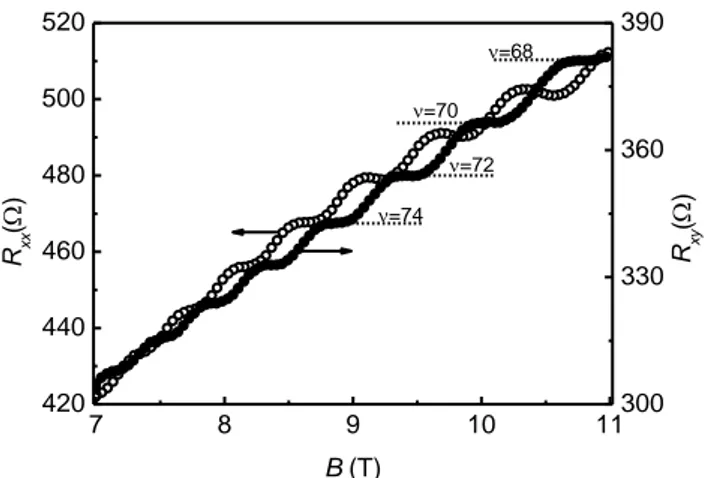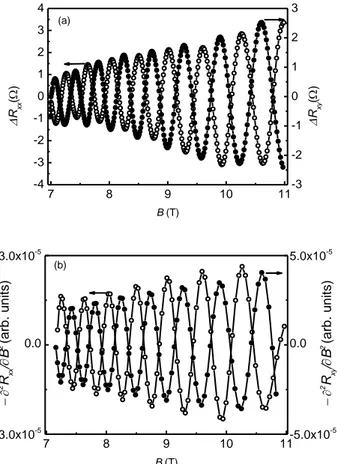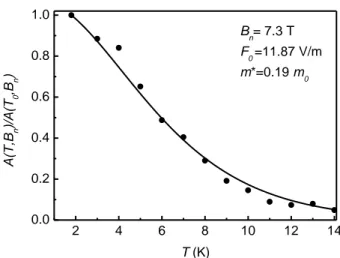OPTOELECTRONICS AND ADVANCED MATERIALS – RAPID COMMUNICATIONS Vol. 10, No. 9-10, September-October 2016, p. 647 - 650
Complementary and alternative technique for the
determination of electron effective mass: quantum Hall
effect
S. ARDALI*, E. TIRAS, E. ARSLANa, E. OZBAYa
Department of Physics, Faculty of Science, Anadolu University, Yunus Emre Campus, 26470 Eskisehir, Turkey
aNanotechnology Research Center, Department of Physics, and Department of Electrical and Electronics Engineering,
Bilkent University, 06800 Ankara, Turkey
The quantum Hall effect measurements in the AlInN/AlN/GaN heterostructure are studied in the temperature range from 1.8 K to 14 K and a magnetic field up to 11 T. The quantized two-dimensional electron gas was placed at the AlN/GaN interface. The Hall resistance of two-dimensional electron gas has been found to be quantized at multiple integers of von Klitzing constant that refers to the integer quantum Hall effect. The experimental data have been used to determine the Fermi energy, carrier density, and effective mass two-dimensional electrons. The results are in agreement with those derived from the longitudinal magnetoresistance in the same structure.
(Received October 6, 2015; accepted September 29, 2016)
Keywords: Quantum Hall effect, Effective mass, GaN
1. Introduction
The alloys of wide bandgap semiconductors, such as GaN and AlN, and a narrow bandgap semiconductor, such as InN, are very attractive semiconductor materials because of not only a very wide range of bandgap between 0.6 to 6.2 eV [1-3] but also because there are other effective characteristics, such as large piezoelectricity, high thermal conductivity, and chemical stabilities. Despite the progress in the development of devices, many fundamental material parameters of these structures are still not fully understood. The knowledge on these parameters, such as effective mass of electrons, is important for the exploration and optimization of this material system in device applications. Determination of the effective mass of electrons, under the environmental conditions in the steady state, provides useful information about the electron–phonon interactions. Furthermore, electron–phonon scattering processes determine the high-field transport phenomena in semiconductors and thus form the basis for many ultrafast optoelectronic devices. The field of electron–phonon scattering processes in semiconductors thus provides a link between fundamental semiconductor physics and high-speed devices. The effective mass of electrons in many semiconductors is also affected from the environmental conditions such as temperature, magnetic field, electrical field, and light intensity. Therefore, the effective mass of electrons from different experimental techniques needs to be determined. Three main techniques are used in the evaluation of the effective mass of materials, namely magneto-optical studies, such as cyclotron resonance, magnetotransport, and Raman spectroscopy. The effective mass of carriers
contributed to conductivity has been extensively studied by using Shubnikov-de Haas (SdH) oscillations in magnetoresistance at low temperature [4-8]. Recently, electron effective masses and quantum lifetimes determined by the SdH oscillations of AlInN/AlN/GaN heterostructures were reported [6, 7].
Since the discovery of the quantum Hall effect, and its use as the resistance standard, it has had an important role [9]. The linear behavior in a low magnetic field (classical regime) and staircase behavior in a high magnetic field (quantum regime) of off-diagonal resistance was found to be interesting by researchers. However, Hall resistance undergoes certain quantum Hall transitions to take on the quantized values, h/ne2 (n=0, 1, 2, ... is the filling factor of the quantum Hall states) in almost all semiconductors, and the filling factor of the quantum Hall states is found to be as n=2+4v (v=0, 1, 2, ...) in monolayer graphene [10]. This observation has led to increased interest again in the quantum Hall effect. Although it is significantly important for finding the number of carriers (Hall concentration) contributing to transport at low magnetic field measurement, the data obtained in high-field measurements are not attributed another task apart from the state to reveal. However, it is shown by us that Hall effect measurements can also be used to obtain the physical parameters of the structures [11, 12]. The effective mass values found with this developed method are in harmony with the values found by other methods.
In a simple degenerate 2D system, with only one type of carrier, the magnetic field dependence of diagonal (xx)
and off-diagonal (xy) components of the resistivity is
648 S. Ardali, E. Tiras, E. Arslan, E. Ozbay 0 0 2 1 xy t c xx (1)
where 0 (=xx(B=0)) is the zero magnetic-field resistivity,
c (=eB/m*) is the cyclotron frequency, m* is the in-plane
effective mass, t is the transport lifetime at zero magnetic
field. The variation of the diagonal component of the resistivity with a magnetic field is well described by the analytical function [13, 14]
c E E T k T k q c F c B c B xx 2 ( ) cos ) / 2 sinh( / 2 / exp 1 2 2 0 (2) where EF is the Fermi energy, q is the quantum lifetime ofelectrons, T is the temperature, kB is the Boltzmann
constant, is the Plank constant, and EF-E1 is the electron
energy with respect to the bottom of the first subband. The exponential term describes the weakening term due to the collision enlargement. The temperature dependent second term, which can be used to determine the effective mass of the carriers, describes the temperature damping of the Landau levels. The in-plane effective mass of 2D electrons can be determined from the temperature dependence of the diagonal (xx) and off-diagonal (xy) components of the
resistivity at constant magnetic field (Bn) using
n B n B n n eB T m k T eB T m k T B T A B T A * 2 sinh . * 2 sinh . ) , ( ) , ( 2 0 0 2 0 (3)
where A(T0, Bn) and A(T, Bn) are the amplitudes of the
oscillation peaks observed at a magnetic field Bn and at
temperatures T0 and T and, respectively. The carrier density (N2D) has been determined from the cosine term
arguments of Eq. (1), period of the oscillations,
1
2*
1
E
E
m
e
N
e
B
D
F
. (4) 2. Experimental detailsThe Al1-xInxN/AlN/GaN (x=0.17) heterostructures
were grown on sapphire substrates in a low pressure MOCVD reactor. The details of Hall-bar shaped sample have been reported elsewhere [6]. The off-diagonal resistance (Rxy) were carried out as functions of the lattice
temperature at a fixed electric field that was low enough to guarantee ohmic conditions and hence to avoid Joule heating. In the experiments, a conventional DC technique in combination with a nanovoltmeter and a constant current source in a cryogen free superconducting magnet
system were used. The current flow was in the plane of the electron gas. Steady magnetic fields up to 11 T were applied perpendicular to the plane of the samples. All of the measurements were taken in the dark.
3. Results and discussions
The typical examples for Hall resistance (Rxy) and
magnetoresistance (Rxx) measurements in the
AlInN/AlN/GaN heterostructure sample measured at 1.8 K are shown in Fig. 1. The oscillations are evidently observable. The overall positive Rxy(B) indicates that the
contribution to conductivity is mostly from electrons. The plateaus with values h/ve2= 25812.8/v (v=68, 70, 72 ... is the filling factor of the quantum Hall states) confirms that the observed Hall plateaus are in the Integer Quantum Hall Effect (IQHE) regime. A similar behavior of Hall resistance with a magnetic field, although less pronounced, was reported previously for GaN-based 2D structures such as AlGaN/GaN heterostructures [15-17] 7 8 9 10 11 420 440 460 480 500 520 B (T) Rxx ( ) 300 330 360 390 =74 =72 =70 R xy ( ) =68
Fig. 1.Magnetoresistance (Rxx) and Hall resistance (Rxy)
as a function of magnetic field for AlInN/AlN/GaN heterostructure sample measured at 1.8 K
It is apparent that the oscillatory effect is superimposed on a monotonically increasing component, which occurs as a result of positive magnetoresistance in the barriers [8]. It is a common knowledge that the monotonic contribution is a quadratic magnetic field dependence of the magnetoresistance.
There are two methods for the elimination of monotonic contribution from the magnetoresistance. These are the polynomial method and the negative second derivative method. In the first method, the oscillating component magnetoresistance has been obtained by subtracting a second-order smooth polynomial from the raw experimental data. In the second method, to exclude the effects of the background magnetoresistance and to extract the quantum oscillations from the magnetoresistance, the negative second derivative of the experimental magnetoresistance data with respect to the magnetic field is calculated [6-8].
Complementary and alternative technique for the determination of electron effective mass: quantum Hall effect 649 The oscillating component of Hall resistance obtained
for the AlInN/AlN/GaN heterostructure sample by using these two methods is shown in Fig. 2. The oscillations have well-defined envelopes and symmetrical about a horizontal line as shown in Fig. 2. Both techniques do not change either the period or the peak position of the oscillations. The periods of the quantum oscillations in diagonal (Rxx) and off-diagonal (Rxy) components of the
resistance are found to be identical. The quantum oscillations observed in Rxx and Rxy are in anti-phase as
a result of minus sign in Eq. 1. It is also evident from Fig. 2 that the oscillations enclose only one period representing that only the bottom subband is populated by electrons.
The periods of the Hall oscillations ((1/B)) have been obtained from the plots of the reciprocal magnetic field (1/Bn), at which the nth peak occurs, against the peak
number n and also from the Fast Fourier Transform (FFT) analysis of the quantum oscillations data (Fig. 3). The period does not depend on the temperature in the range from 1.8 K. The carrier density (N2D) in the subband and
Fermi energy have been determined from the Eq. (4) together with the effective mass (m*) of 2D electrons as obtained from the temperature dependence of amplitude of the oscillations (see below). The result obtained for N2D is
7.25x1016 m-2 and Fermi energy EF-E1=92.26 meV for the
AlInN/AlN/GaN heterostructure sample.
7 8 9 10 11 -4 -3 -2 -1 0 1 2 3 4 Rxx ( ) B (T) -3 -2 -1 0 1 2 3 Rxy ( ) (a) 7 8 9 10 11 -3.0x10-5 0.0 3.0x10-5 2 R xx / B 2 (ar b. u nits) B (T) -5.0x10-5 0.0 5.0x10-5 (b) 2 R xy / B 2 (ar b. u nits)
Fig. 2. Derivation of the oscillating components of the magnetoresistance and Hall resistance obtained by (a) polynomial method and (b) negative second derivative method. The measurement temperature is 1.8 K
2 4 6 8 0.10 0.12 0.14 (1/B) = 0.0067 T-1 Ef-E1= 92.26 meV N2D= 7.25x1016 m-2 1/ B ( T -1 ) Peak number 0 10 20 30 40 0 50 100 150 FF T Am plitude ( arb. un it s ) Frequency (units of 1/NT)
Fig. 3. The reciprocal magnetic field (1/Bn) plotted as a
function of the oscillation peak number (n) of AlInN/AlN/GaN heterostructure. The full squares correspond to the data given in Fig. 2. The straight line is the least-squares fit to the experimental data. The insert shows the fast Fourier spectrum of the oscillations (N = 28 and T = 4.9 x10-2 T-1 is the sampling interval). There is no evidence for the population of higher subbands or for any contribution from higher harmonics
The temperature dependent Hall oscillations is shown in Fig. 4, where only the data sets measured at three different temperatures are presented for clarity. Fig. 5 shows that the temperature dependence of relative amplitude A(T,Bn)/A(T0,Bn) of the oscillations. The
A(T,Bn)/A(T0,Bn) decreases with increasing temperature in
accordance with the thermal damping factor (Eq. (2)). The effective mass of 2D electrons in the AlInN/AlN/GaN heterostructure sample can be determined from the temperature dependence of the Hall oscillations amplitude at constant magnetic field using Eq. 3. A similar analysis made for all the oscillation peaks in Hall resistance observed in the magnetic-field range from 7 to 11 T have established that the in-plane effective mass of 2D electrons in AlInN/AlN/GaN heterostructure sample is essentially independent of the magnetic field. The results found for the effective mass (m*=19m0) of 2D electrons in the
AlInN/AlN/GaN heterostructure sample determined from the temperature dependence of Hall oscillations are in good agreement with those determined from SdH effect measurements [6]. 7 8 9 10 11 -6.0x10-5 0.0 6.0x10-5 TL = 1.8 K TL = 10 K TL = 14 K 2R xy / B 2(ar b. u nits) B (T)
Fig. 4. The effects of temperature on the oscillations arising from the electrons in the subband, as extracted from the Rxy(B) data for an Al0.83In0.17N/AlN/GaN
heterostructure sample. The solid curves through the experimental data points are intended as a guide for the eye
650 S. Ardali, E. Tiras, E. Arslan, E. Ozbay 2 4 6 8 10 12 14 0.0 0.2 0.4 0.6 0.8 1.0 A (T,B n )/A (T 0 ,B n ) Bn= 7.3 T F0 =11.87 V/m m*=0.19 m0 T (K)
Fig. 5. The temperature dependence of the normalized amplitude of the oscillation peak at a fixed magnetic field Bn in Al0.83In0.17N/AlN/GaN heterostructure. The data
points are represented by the full squares and full curves are the best fits of Eq. (7) to the experimental data
4. Conclusions
The carrier density (N2D), effective mass (m*) and Fermi energy with respect to subband energy (EF-E1) in Al0.83In0.17N/AlN/GaN heterostructures have been determined from the quantum oscillations in Hall resistance. The results obtained for the Al0.83In0.17N/AlN/GaN heterostructure by measuring the quantum oscillations in Hall resistance are in good agreement with those determined from the SdH effect in magnetoresistance. These results constitute an independent and definite validation of the reliability of quantum oscillations in Hall resistance as a tool for effective mass determinations in semiconductors.
Acknowledgements
This study was supported by the Anadolu University Scientific Research Projects Commission under grant nos. 1306F137 and 1404F170 as well as TUBITAK Ankara under grant no. 110T377.
References
[1] Y. Sakai, P. C. Khai, T. Egawa, J. Appl. Phys. 110, 103523 (2011).
[2] J. F. Carlin, M. Ilegems, Appl. Phys. Lett. 83, 668 (2003).
[3] K. Kubota, Y. Kobayashi, K. Fujimito, J. Appl. Phys. 66, 2984 (1989).
[4] A. M. Kurakin, S. A. Vitusevich, S. V. Danylyuk, H. Hardtdegen, N. Klein, Z. Bougrioua, A. V. Naumov, A. E. Belyaev, J. Appl. Phys. 105, 073703 (2009). [5] I. Vurgaftman, J. R. Meyer, L. R. Ram-Mohan, J. Appl. Phys. 89, 5815 (2001).
[6] E. Tiras, S. Ardali, E. Arslan, E. Ozbay, J. Electron. Mater. 41, 9 (2012).
[7] A. Bayraklı, E. Arslan, T. Fırat, S. Ozcan, O. Kazar, H. Cakmak, E. Ozbay, Phys. Status Solidi A 209, 1119 (2012).
[8] N. Balkan, H. Celik, A. J. Vickers M. Cankurtaran, Phys. Rev. B 52, 210 (1995).
[9] K. Klitzing, G. Dorda, M. Pepper, Phys. Rev. Lett. 45, 494 (1980).
[10] A. M. R. Baker, J. A. Alexander-Webber, T. Altebaeumer, R. J. Nicholas, Phys. Rev. B 85, 115403 (2012).
[11] E. Tiras, M. Cankurtaran, H. Celik, N. Balkan, Phys. Solidi Status A 186, 123 (2001).
[12] S. Ardali, E. Tiras, Physica E 47, 207 (2013). [13] P. T. Coleridge, R. Stoner, R. Fletcher, Phys. Rev. B 39, 1120 (1989).
[14] M. Cankurtaran, H. Celik, E. Tiras, A. Bayrakli, N. Balkan, Phys. Stat Sol. B 207, 139 (1998).
[15] W. Knap, S. Contreras, H. Alause, C. Skierbiszewski, J. Camassel, M. Dyakonov, J. L. Robert, J. Yang, Q. Chen, M. Asif Khan, M. L. Sadowski, S. Huant, F. H. Yang, M. Goiran, J. Leotin, M. S. Shur, Appl. Phys. Lett. 70, 2123 (1997).
[16] M. J. Manfra, L. N. Pfeiffer, K. W. West, H. L. Stormer, K. W. Baldwin, J. W. P. Hsu, D. V. Lang, R. J. Molnar, Appl. Phys. Lett. 77, 2888 (2000). [17] S. Contreras, W. Knap, E. Frayssinet, M. L. Sadowski, M. Goiran, M. Shur, J. Appl. Phys. 89, 1251 (2001).
____________________ *


